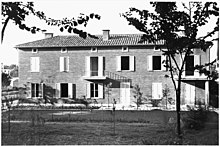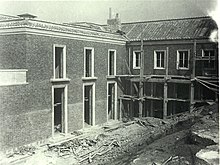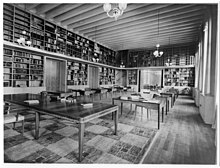Swedish Institute in Rome



The Swedish Institute in Rome (Swedish: Svenska institutet i Rom, Italian: Istituto Svedese di studi classici a Roma) is a research institution that serves as the base for archaeological excavations and other scientific research in Italy. It also pursues academic instruction in archaeology and art sciences as well as arranging conferences with themes of interest to the institute. The institute has at its disposal a building in central Rome, designed by Ivar Tengbom, with a relatively well-supplied library, archaeological laboratory and around twenty rooms and smaller apartments for the use of visiting researchers and holders of scholarships.
The institute was founded in 1925 by, among others, King Gustaf VI Adolf, then Crown Prince of Sweden.
Excavations
The institute has conducted several major excavations. Before World War II, excavations were carried out on the Forum Romanum among other places, but since then most of them have taken place in southern Etruria.[1]
- Acquarossa,[2] 1966–1978[3]
- San Giovenale,[4] 1956–1965[5]
- Luni sul Mignone, 1960–1963[6][7]
- Selvasecca di Blera, 1965–1971[8][9]
Directors
- Axel Boëthius (1926–35, 1952–53, 1955–57)
- Einar Gjerstad (1935–40)
- Erik Sjöqvist (1940–48)
- Arvid Andrén (1948–52, 1964–66)
- Olov Vessberg (1953–55)
- Erik Wellin (1957–61)
- Bengt E. Thomasson (1961–64)
- Paul Åström (1967–70)
- Carl Eric Östenberg (1970–78)
- Carl Nylander (1979–97)
- Anne-Marie Leander Touati (1997–2001)
- Barbro Santillo Frizell (2001–2013)
- Kristian Göransson (2013–2019)
- Ulf R. Hansson (2019–)
See also
References
- ^ Istituto Svedese di studi classici a Roma - History Archived 2017-03-09 at the Wayback Machine
- ^ The Etruscans, Graeme Barker & Tom Rasmussen, page 299
- ^ Charlotte Wikander (1988). Acquarossa. Astrom. ISBN 978-91-7042-134-1.
- ^ The Etruscans, Graeme Barker & Tom Rasmussen, page 319
- ^ Bertil Hallert; Svenska institutet i Rom; Italy. Soprintendenza alle antichità dell'Etruria meridionale (1981). San Giovenale: Results of excavations conducted by the Swedish institute of classical studies at Rome and the Soprintendenza alle antichità dell'Etruria meridionale. Gleerup. ISBN 978-91-7042-078-8.
- ^ Luni Sul Mignone: fasc. 1. The Iron age settlement on the Acropolis, by T. Wieselgren. Aström. 1975. ISBN 978-91-7042-048-1.
- ^ Luni Sul Mignone: Results of Excavations Conducted by the Swedish Institute of Classical Studies at Rome and the Soprintendenze Alle Antichità Dell'Etruria Meridionale. Aström. 1975.
- ^ Notizie degli scavi di antichità. Accademia nazionale dei Lincei. 1969.
- ^ Jeffrey A. Becker; Nicola Terrenato (2012). Roman Republican Villas: Architecture, Context, and Ideology. University of Michigan Press. ISBN 978-0-472-11770-3.
